Abstract
Alluvial formations are important sources of abundant and dependable ground water supplies. Because of large saturated thickness and high well yields, these formations have been extensively exploited for large-scale supplies of water for industrial, irrigation and urban use. Intensive use of ground water from these formations has led to several problems. Such is the case in Punjab also. Despite the fact that Punjab occupies only 1.57% geographical area of India, it contributes more than 50 % grain in the central grain pool. More than 83% of land in Punjab is under agriculture as compared to 40.38% of national average. The cropping pattern of wheat and paddy rotation has led to manifold increase in irrigation water demand. Injudicious surface water irrigation policies, indiscriminate / excessive ground water pumpage due to free electricity coupled with irrational irrigation and agricultural practices have led to situation wherein fresh ground water resources of the state have depleted at an alarming rate in most parts of the state. On the other hand, the south-western parts of Punjab are facing severe water logging problems. Thus the state has to have a twin pronged strategy to manage its ground water resources – i) to arrest the declining trend of ground water and ii) to combat water logging.
Punjab is occupied by Quaternary alluvial deposits of Indus river basin. In major part of thestate, ground water levels are in the range of 10 to 20 meters. However around major cities like Jalandhar, Ludhiana, Patiala, Amritsar and Sangrur, water levels are 20 to 40 meters deep. The long-term water level fluctuation data indicates that water levels in major parts of the state have declined drastically. As per the ground water assessment carried out, net dynamic ground water resources of Punjab State are 21.443 MCM (Million Cubic meters), whereas net draft is 31.162 MCM, leading to ground water deficit of 9.719 MCM. The stage of ground water development for the State as a whole is 145% and the State falls under “over- exploited” Category.
Apart from several water management strategies, like better irrigation and on-farmmanagement practices, change in cropping pattern, banning early plantation of paddy etc., the main emphasis in this paper has been laid on the utilization of non-committed surplus monsoon rainfall runoff. As per the Master Plan for artificial recharge to ground water prepared for Punjab state, about 1200 MCM of water is available from surplus monsoon runoff. By adopting rain water harvesting and artificial recharge to ground water by utilizing this water, the negative impact on the ground water regime can be checked, to quite an extent. Central Ground Water Board has taken up several pilot demonstrative artificial recharge projects in Punjab that can be replicated in other parts of the state too. Some of these projects have also been discussed in this paper.
General Features
Punjab State, located in northwestern part of India, has an area of 50,362 sq.km. which constitutes 1.57% of total area of country. The economy of the state is primarily agro based. The state falls in the Indus basin and is drained by three major rivers - the Ravi, Beas and the Sutlej apart from other drainage channels including the Ghaggar that drains the southern parts. In Punjab state about 85% of geographical area is under agriculture. It has a cropping intensity of 184%. Traditionally, the farmers had followed the Maize-Wheat or Sugarcane-Maize-Wheat cropping pattern but during last about four decades, they have shifted to Wheat-Rice cropping pattern thereby leading to increased demand onirrigation water. There were only 1.92 lac shallow tube wells in the State, during the year 1970, which increased to 6.00 lac in 1980, and presently there are more than 10 lac tube wells in the state.
Ground Water Regime
Aquifer System
Almost 90% of the state is underlain by Quaternary alluvial deposits except the northeastern part that is occupied by Tertiary formations outcropping as Siwalik Hills. The fluvial deposits of the Ravi, Beas and Sutlej rivers have formed the alluvial plains. The quaternary deposits are divided into:
(i) Piedmont deposits occurring along a narrow belt along the Siwaliks locally known as“Kandi”;
(ii) The alluvial plains which are the most important ground water reservoir;
(iii) Aeolian deposits occurring in the southwestern part of the State; and
(iv) An intermontane valley near Anandpur Sahib in Ropar district.
Based on exploratory drilling carried out by Central Ground Water Board down to about 450 meters below ground level in a major part of the state, it has been deciphered that thick fresh water aquifers exist throughout the State and are laterally and vertically extensive and persistent in nature. However, in southwestern parts, the thickness of fresh water aquifer is much less as compared to the other parts because area is underlain by brackish / saline water. The thickness of fresh water sediments barring southwestern part is more than 350m (explored depth). In northeastern part of the State the thickness of fresh water sediments is greater than 450m (explored depth). In southwestern part the thickness of fresh water sediments varies from 10 to 200m, it decreases towards extreme southwestern corner of the State where it is less than 10m.
The following aquifers zones have been delineated in the state based on the yield characteristics of the aquifers.
i) Local and discontinuous, fairly thick aquifers having fresh water down to 50 meters withaverage yield of wells below 50m3/hour covering an area of about 12,000 sq.km. in Faridkot, Moga, Bathinda, Mansa, southern parts of Sangrur and Ferozepur districts.
ii) Regionally extensive and fairly thick aquifers down to 300 meters with an average yield of wells between 50 – 150 m3/hours occur in a narrow strip extending from south of Fazilka to north of Moga and also in the north eastern parts of Gurdaspur, Hoshiarpur, Nawanshahar, Patiala, Ropar districts and Anandpur Sahib valley of Ropar district. This comprises an area of about 7000 sq.km.
iii) Regionally extensive and fairly thick aquifers down to 450 meters with an average yield of wells above150 m3/hour occur in an area of about 29,000 sq.km. covering whole of Amritsar, Kapurthala, Fatehgarh Sahib, Ludhiana, Patiala districts and parts of Sangrur, Gurdaspur, Ferozepur, Patiala, Nawanshahar, Jalandhar and Ropar districts.
iv) Hilly terrain of about 2000 sq.km. in parts of Ropar, Gurdaspur, Hoshiarpur and Nawanshahar districts is underlain by semi-consolidated formations having limited yield potentials below 50 m3/hour except plateau area (beet area) in Garhshankar block of Hoshiarpur district which has yield potential of 100m3/hr to 200 m3/hr.
v) Auto flow area – mostly in Gurdaspur district along the right bank of the Beas and Chaki khad and along left bank of the Ravi and Anandpur Sahib block of Ropar district. The artesian flowing aquifers occur generally below 40 metres depth and along left bank of Ravi river up to 155 m.bgl. The free flow discharge ranges between 1 to 70m3/hour.
Ground Water Level Behavior
The depth to ground water in a major part of the state ranges between 10 to 20mbgl except in the southwestern part where it is less than 5 mbgl. Depth to water level is more than 20mbgl around major cities like Jalandhar, Ludhiana, Amritsar, Patiala, Fatehgarh Sahib, Nawanshahar and Sangrur. Water levels deeper than 50 m occur in the Plateau region of Garshankar Block of Hoshiarpur district. Out of 50,362 Sq.km area of the State, 39,000 Sq.Km area (78%) shows a decline in water levels. The decadal fluctuation in water level show fall in water levels is between less than 2 meters to more than 4 meters.
Ground Water Resources
Groundwater resource estimation of Punjab state has been carried out as per GEC 1997 methodology. The last assessment of ground water was carried out as on 31.3.2004. According to this assessment, net ground water resources of Punjab State are 21.443 BCM, whereas net draft was 31.162 BCM, leading to ground water deficit of 9.719 BCM. The stage of ground water development for the State was 145% and the State as a whole falls under “over exploited” Category. The following table-1 gives district wise ground water resources:
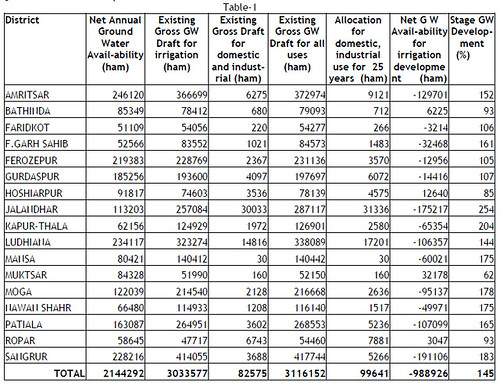 Out of 137 blocks of the State, 103 blocks are over exploited, 5 blocks are critical, 4 blocks semi critical and 25 blocks are in safe category. The safe category blocks fall all along the foothills where water levels are deep or in the southwestern part of the state where water logging occurs or water is not potable. A map showing ground water development in Punjab(Fig-i) has been prepared.
Out of 137 blocks of the State, 103 blocks are over exploited, 5 blocks are critical, 4 blocks semi critical and 25 blocks are in safe category. The safe category blocks fall all along the foothills where water levels are deep or in the southwestern part of the state where water logging occurs or water is not potable. A map showing ground water development in Punjab(Fig-i) has been prepared.Ground Water Management
In the state of Punjab, there are several problems that are associated with ground water. Whereas a greater part of the state is facing declining ground water levels due to over-exploitation of the resource, some part is facing rising water levels and concomitant water logging. There are cases of pollution of ground water due to various human activities as well as shortage of clean drinking water in urban areas. Some of the major issues that need to be addressed are outlined below:
1. Ground Water Depletion Due To Overexploitation
2. Rising Water Table and Water Logging
3. Saline / Brackish Water – Use and Disposal
4. Flood Plains – Scope For Ground Water Development
5. Water Shortage In Urban Areas
6. Ground Water Development in Hilly Areas
7. Ground Water Pollution
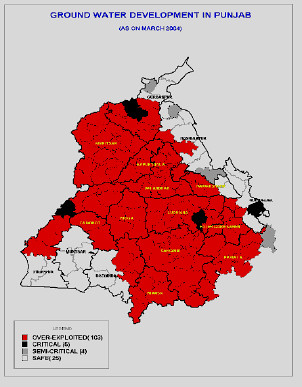 In the overexploited areas, mainly resorting to artificial recharge and following various conservation practices can augment ground water. The conservation would include:Increasing water use efficiency ,change in cropping pattern, change in irrigation policy, timely plantation of paddy, promotion of sprinkler and drip irrigation, realistic irrigation power pricing, mass awareness program, ground water regulation and recycling of water.
In the overexploited areas, mainly resorting to artificial recharge and following various conservation practices can augment ground water. The conservation would include:Increasing water use efficiency ,change in cropping pattern, change in irrigation policy, timely plantation of paddy, promotion of sprinkler and drip irrigation, realistic irrigation power pricing, mass awareness program, ground water regulation and recycling of water.In this paper only ground water management strategy for overexploited areas by artificial recharge has been discussed.
Artificial Recharge to Ground Water
Master plan for artificial recharge to ground water has been prepared for Punjab state. Punjab state is endowed with good surface water resources. Master plan for artificial recharge to ground water has been prepared as follows:
i) Identification of area suitable for artificial recharge to ground water,
ii) Estimation of subsurface storage space and quantity of water needed to saturate theunsaturated zone,
iii) Quantification of surface water requirement and surplus runoff available for artificial recharge in each district,
iv) Working out suitable recharge structures, their numbers, and capacity to rechargewith available resource
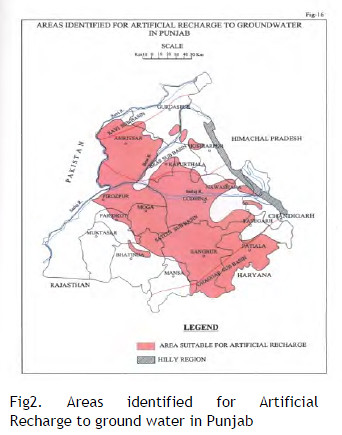 The area feasible for artificial recharge has been demarcated on the basis of depth to water level and declining trend. In the state 26,650 km2 area has been identified for artificial recharge, where water levels either have declining trend or are deep and sufficient thickness of vadose zone is available to store the recharged water. The area lies mainlyin Amritsar, Kapurthala, Jalandhar, Ludhiana, northern parts of Ferozepur, Moga, Sangrur ,Patiala and small parts of Ropar and Nawanshahar districts extending in a north west to south east direction. Based on the area suitable for artificial recharge and thickness of vadose zone, it has been computed that about 18,866
The area feasible for artificial recharge has been demarcated on the basis of depth to water level and declining trend. In the state 26,650 km2 area has been identified for artificial recharge, where water levels either have declining trend or are deep and sufficient thickness of vadose zone is available to store the recharged water. The area lies mainlyin Amritsar, Kapurthala, Jalandhar, Ludhiana, northern parts of Ferozepur, Moga, Sangrur ,Patiala and small parts of Ropar and Nawanshahar districts extending in a north west to south east direction. Based on the area suitable for artificial recharge and thickness of vadose zone, it has been computed that about 18,866MCM of sub-surface storage potential exists below 3 meter below ground level which can be utilized to store additional water through artificial recharge. Total water required for saturating this dry zone has been assessed keeping in view the fact that the average recharge efficiency of artificial recharge structures is about 75% only. Thus, to arrive at the total volume of source water required at the surface, the unsaturated space is multiplied by 1.33(reciprocal of 0.75). Thus the total source water requirement works out to be 25089 MCM. The basin wise estimates are given in table-2:
 However, it is very important that only non-committed water resources are considered for artificial recharge in the state. These have been estimated as 1201 MCM. Artificial recharge schemes by using surface run-off in drains and spare canal water during lean period for augmentation of ground water can be taken up for arresting the declining water table. Artificial recharge of surface runoff needs to be planned by providing long trenches with recharge wells in the drains, constructing low height dams in the bed of choes in Kandi area, improving the watershed management in rural areas for arresting the wasteful runoffs during rains and channelizing these in village ponds and other local depressions. Spare canal water during monsoon may be injected into the ground through recharge wells, dug-cum-bore wells, cavity wells, existing ponds may be cleaned and deepened to increase the recharge through pond beds or shaft-cum-recharge wells may be constructed on sides of ponds.
However, it is very important that only non-committed water resources are considered for artificial recharge in the state. These have been estimated as 1201 MCM. Artificial recharge schemes by using surface run-off in drains and spare canal water during lean period for augmentation of ground water can be taken up for arresting the declining water table. Artificial recharge of surface runoff needs to be planned by providing long trenches with recharge wells in the drains, constructing low height dams in the bed of choes in Kandi area, improving the watershed management in rural areas for arresting the wasteful runoffs during rains and channelizing these in village ponds and other local depressions. Spare canal water during monsoon may be injected into the ground through recharge wells, dug-cum-bore wells, cavity wells, existing ponds may be cleaned and deepened to increase the recharge through pond beds or shaft-cum-recharge wells may be constructed on sides of ponds.Central Ground Water Board has carried out 21 pilot projects for artificial recharge to ground water in the state of Punjab. These projects were under taken in Amritsar, Jalandhar, Kapurthala, Ludhiana, Moga, Patiala, Sangrur, and Ropar and Patiala districts. Artificial recharge projects were under taken by utilizing surplus canal water, utilizing runoff in the drains, through village ponds, and rooftop rainwater. Recharge structures feasible are, dug cum bore well, modifying the drain bed, vertical andlateral trenches, recharge wells and check dam. Some findings of pilot artificial recharge projects are as follows:
Artificial recharge to ground water at Bhattian Canal Colony, District Ludhiana
Stage of ground water development of Khanna block of Ludhiana district is 194 %, highest in Ludhiana district as on 31.3.2004. Artificial recharge scheme was undertaken at Bhattian Canal Colony, village Bhattian, district Jalandhar utilizing surplus canal water of Khanna distributary, which originates from Samrala distributary of Bharka main line canal. It is observed that farmers rely more on ground water extraction through tube wells as it is readily available throughout the year in their own lands. The water from canals and distributaries goes waste during non showing season and monsoon period. The scheme aims to recharge the ground water by utilizing surplus water of Khanna distributary.
The water levels of Khanna area show a decline of 2.60 meters from year 1991 to 2002 (during the period of study). Thus water levels are declining @ 21 cm /year. The dry zone in the area extends up to 15 meters. By excluding top 3 meters not to be recharged to avoid water logging condition, the remaining 12 meter of dry zone has de-saturated aquifer material having a volume of 60 MCM.
Subsurface geological formations of the area are top clay mixed with fine sand and silt layer up to a depth of 4.5 meters, followed by medium to fine sand up to depth of 40 meters. One distribution tank of 5m x 4m x 3 m was constructed to divert the surplus canal water. To connect the distribution tank with canal, 10 m long R.C.C. pipe of 225 mm dia was laid(Fig-3)
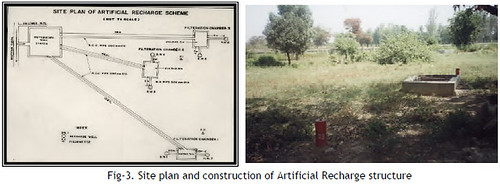 From distribution tank, the desilted water was fed into three filtration chambers of size 2m x 1.5m x 2.5m each through 200mm dia RCC pipes of length 58m, 46m and 108 meters. The filtration chambers connected to a set of recharge wells through MS pipe of 200mm dia of varying length .In order to inject canal water under gravity into the unconfined aquifer system, 6 recharge wells were constructed at different locations. Two piezometers (observation wells) were also constructed to monitor the impact of recharge on ground water. The recharge wells were constructed to a depth of 31 to 35 meters bytapping aquifers below 24 meters. The water for artificial recharge has been diverted from the distributary by providing 2 RCC pipes of 225 mm (9” dia) and 101mm (4”) dia . As no regulator has been provided for regulating water to the recharge structures, hence during the period of canal running days, the water will be automatically diverted in to the distribution tank and after passing through filtration chambers recharge the unconfined aquifer through six recharge wells. The canal runs on an average 167 days in a year and volume of canal water available for recharge is 952301 m3 with an average discharge rate of 66 lps.
From distribution tank, the desilted water was fed into three filtration chambers of size 2m x 1.5m x 2.5m each through 200mm dia RCC pipes of length 58m, 46m and 108 meters. The filtration chambers connected to a set of recharge wells through MS pipe of 200mm dia of varying length .In order to inject canal water under gravity into the unconfined aquifer system, 6 recharge wells were constructed at different locations. Two piezometers (observation wells) were also constructed to monitor the impact of recharge on ground water. The recharge wells were constructed to a depth of 31 to 35 meters bytapping aquifers below 24 meters. The water for artificial recharge has been diverted from the distributary by providing 2 RCC pipes of 225 mm (9” dia) and 101mm (4”) dia . As no regulator has been provided for regulating water to the recharge structures, hence during the period of canal running days, the water will be automatically diverted in to the distribution tank and after passing through filtration chambers recharge the unconfined aquifer through six recharge wells. The canal runs on an average 167 days in a year and volume of canal water available for recharge is 952301 m3 with an average discharge rate of 66 lps.In order to assess the impact of recharge on ground water, water from canal at a rate of 5702m3/day (@ 66 lps ) was recharged through six recharge wells. The water was recharged from 1st July 2002 to 31st Jan, 2003. During the period water was available for 118 days. The volume of water was recharged varies from 34214m3 (Oct.2002) to 1,65,370m3 (Aug,2002).
Artificial recharge to ground water in Patiala Nadi, District Patiala
Artificial recharge scheme was undertaken in the bed of Patiala Nadi, in between village Kalwa and Daun Kalan in Patiala district. Patiala district is one of the overexploited district of Punjab with stage of ground water development as 165 % ( as on 31.3.2004). The ground water development of Patiala block is 188 %. The depth to water level of the area during the period from 1994 to 2000 shows decline of water levels by 2.65 meters, indicating a fall of 0.43 m/year. Subsurface geology mainly constitute top covering clay layer followed by fine to medium sand down to depth of 26 meters.
The study area(Fig-4) is divided into three slices. In slice I & II, twenty trenches of 10 m in length, 3 meter wide and 3 meter in depth with one recharge well of 26 meter depth in each trench were constructed. In slice III, one lateral trench of 125 meter in length with 5 recharge wells was also constructed. The recharge wells were constructed at a distance of 25 meters from each other. The trenches were filled with inverted filter. Piezometers were also constructed on either side of the Patiala Nadi. Four sets of rectangular weirs to monitor the discharge in Patiala Nadi were constructed.
Recharge impact assessment was carried out in October 2002 and August 2003. Discharges were measured through rectangular weir in the upstream and down stream of trenches. It is observed that in small trenches with recharge wells the discharge at upstream was 3560 lit/sec whereas at downstream it was 3350 lit/sec. It was assessed that water was recharged in twenty recharge structures at the rate of 210 lit/sec with the intake capacity of each recharge structure as 10.5 lps. In the lateral trench the recharge rate was 6.4 lps/running length of the trench.
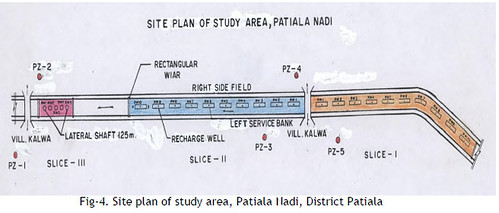
Artificial recharge to ground water at Village Channian, district Jalandhar
Artificial recharge scheme was undertaken by utilizing surplus canal water and pond water in the village Channian. The stage of ground water development of Nakodar block of Jalandhar district is 213% as on 31.3.2004. The scheme consists of one recharge well of 81 meter depth and two piezometers of 73 and 34 meter depth , modifying abandoned dug well with recharge well of 33.5 meter and a shaft of 3 meter dia. with recharge well for recharging pond water. The structures were designed to utilize 2,88,924 m3/year canal water and 16,000 m3 pond water for recharge. During recharge impact assessment from March 2000 to October 2002 about 8,47,700 m3 canal water was recharged through recharge well and dug well cum recharge well. It is also estimated that 47,385 m3 rainwater and village waste water from pond was recharged through shaft cum recharge well.
Roof Top Rain Water Harvesting at Basic Medical Sciences Block, Punjab University, Chandigarh.
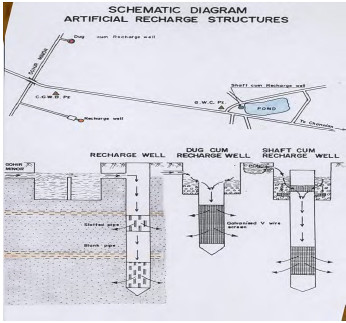 In Chandigarh (UT), the water requirement of the city is met through deep tube wells and by canal water. The city covers an area of 114 km2, out of which 36 km2 is rural and 78 km2 is urban. Due to increase in urbanization the paved areas are increasing leading to decrease in unpaved areas for natural recharge. The recharge is mainly through rainfall, which takes place in the recharge areas in the northeastern and eastern parts of the city. Deeper aquifer system sustain majority of the ground water withdrawal resulting into the decline in water levels, which needs replenishment. Due to heavy development of ground water, water levels of deeper aquifers in Chandigarh are continuously declining. The best option for the city is to harvest rooftop rainfall from buildings and paved areas. With this in view, roof top rainwater harvesting for artificial recharge was taken up in the building of Basic Medical Sciences of Punjab University.
In Chandigarh (UT), the water requirement of the city is met through deep tube wells and by canal water. The city covers an area of 114 km2, out of which 36 km2 is rural and 78 km2 is urban. Due to increase in urbanization the paved areas are increasing leading to decrease in unpaved areas for natural recharge. The recharge is mainly through rainfall, which takes place in the recharge areas in the northeastern and eastern parts of the city. Deeper aquifer system sustain majority of the ground water withdrawal resulting into the decline in water levels, which needs replenishment. Due to heavy development of ground water, water levels of deeper aquifers in Chandigarh are continuously declining. The best option for the city is to harvest rooftop rainfall from buildings and paved areas. With this in view, roof top rainwater harvesting for artificial recharge was taken up in the building of Basic Medical Sciences of Punjab University.The Basic Medical Sciences block has roof area of about 2100 m2. Subsurface geology of the area shows that at the top sand clay layer of 3m exists overlying the shallow unconfined aquifer extending down to about 14m. Below 14m the aquifer zones exist alternating with thick clay zones down to depth of 73m. Water bearing zones are comprised of fine to medium sand mixed with gravel and pebble. The thickness of clay beds varies from 3m to 17m and aquifer zones are 1.53 m to 12.50 m in thickness.
The rooftop rainwater harvesting structure consists of mainly three components, namely, rainwater conveyance system, collection and filtration chamber and a recharge well. The conveyance system to collect and transport rainwater from the rooftop to the collection chamber was already available and laid out up to the corner of the play ground. A trench of 10 m length, 1.7m width and 2.5m depth was constructed in the corner of the play ground near Basic Medical Sciences block and filled with inverted filter. Recharge well 66 m depth was constructed by tapping aquifer zones from 45-51m and 57.50 to 63.50 m depth. Considering spillage, evaporation, leakage and other wastage as 10% ,theremaining 90% of rainfall that falls on the roof top is considered as effective runoff from the roof top. The total rainfall received during the study period was 1201 mm, resulting in 2135m3 of roof top surface runoff. Out of this, 1985m3 of water is estimated to be recharged to the ground water reservoir, which is 93% of roof top runoff generated.
Acknowledgement
The author gratefully acknowledges various studies pertaining to artificial recharge carried out by his colleagues from Central Ground Water Board in the state of Punjab, data from which has been extensively used in this paper. The author is thankful to Sri B. M. Jha, Ex-Chairman, and Dr S. C. Dhiman, Chairman, Central Ground Water Board for their encouragement and guidance in writing of this paper.
References
• Master plan for Artificial Recharge to Ground Water in India; CGWB ; 2002
• Impact Assessment of Artificial Recharge to Ground Water Utilizing Canal Water and Surplus Pond Water at Village Channian, Nakodar Block, District Jalandhar, Punjab; CGWB ; 2003
• Impact Assessment of Artificial Recharge to Ground Water Utilizing Runoff Generated In Patiala Nadi, Block Patiala, District Patiala, Punjab; CGWB ; 2004
• Dynamic Ground Water Resources of India ( As on March, 2004); CGWB ; 2006
• Manual on Artificial Recharge to Ground Water; CGWB ; 2007
Sushil Gupta
Member(SAM), Central Ground Water Board
Path Alias
/articles/ground-water-management-alluvial-areas-punjab
Post By: Hindi